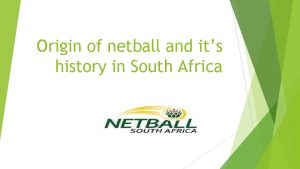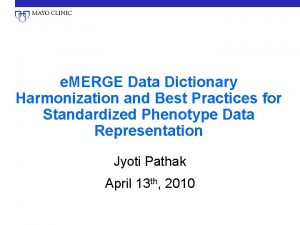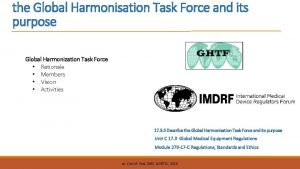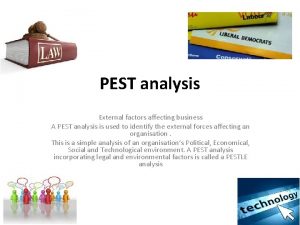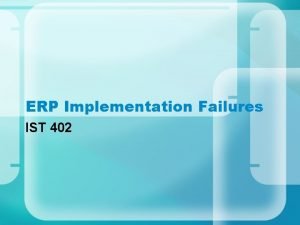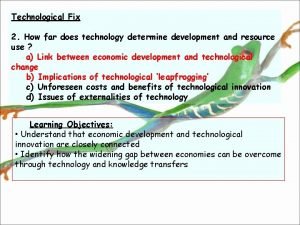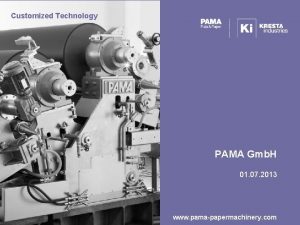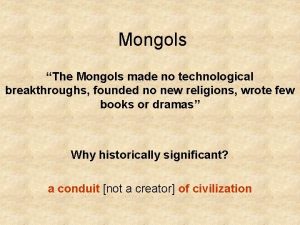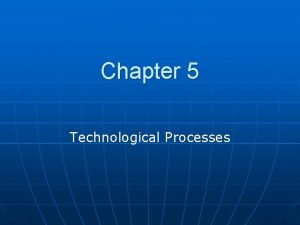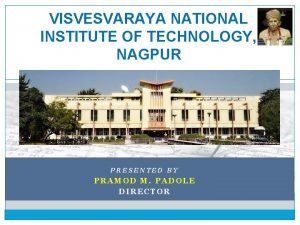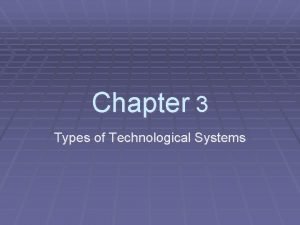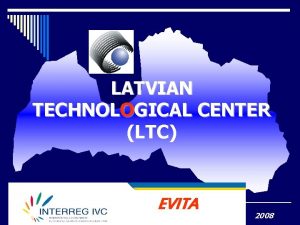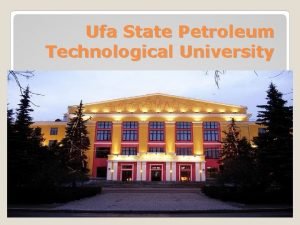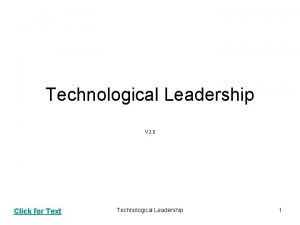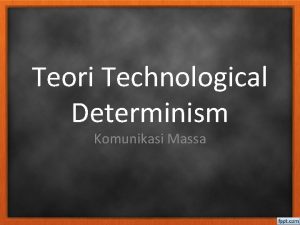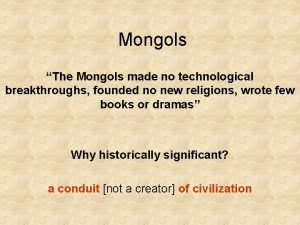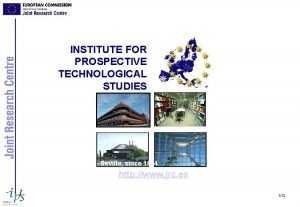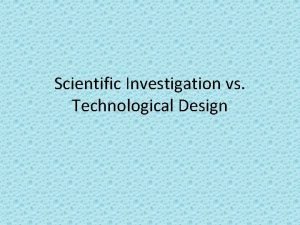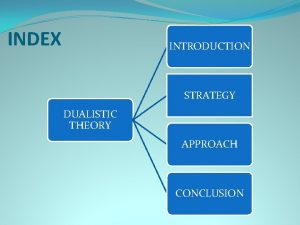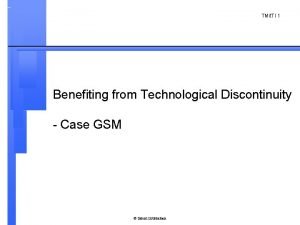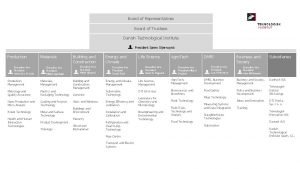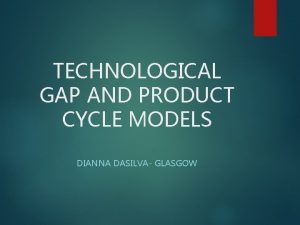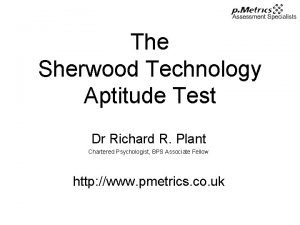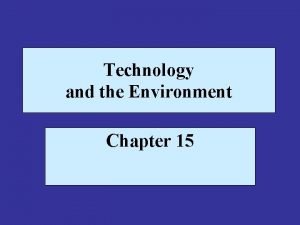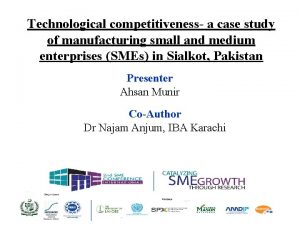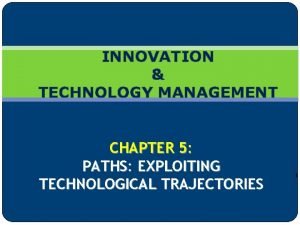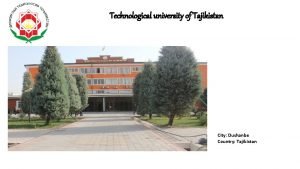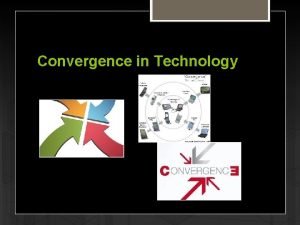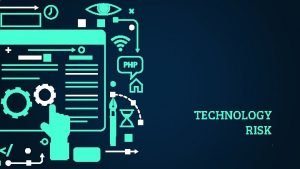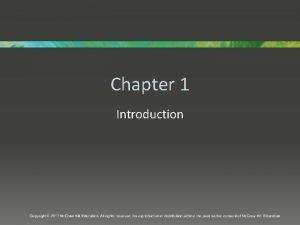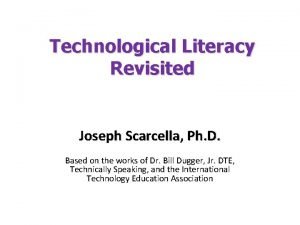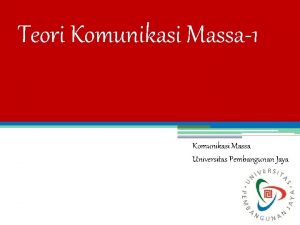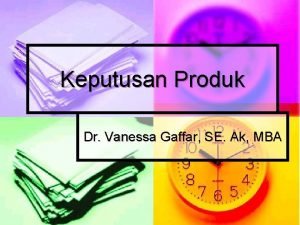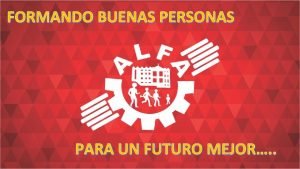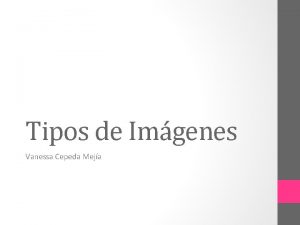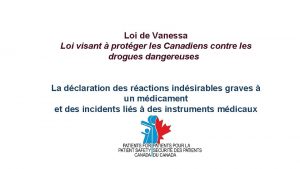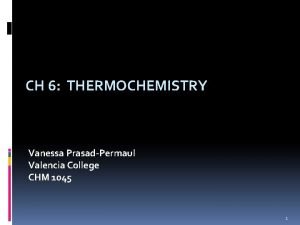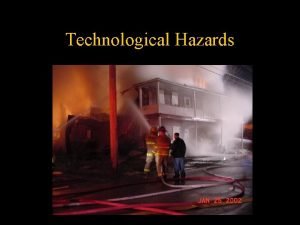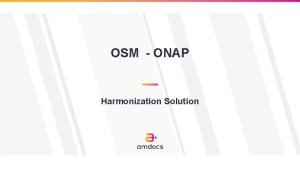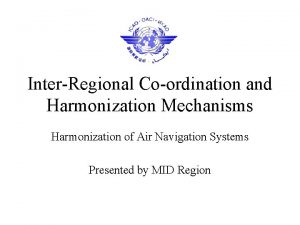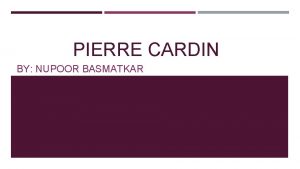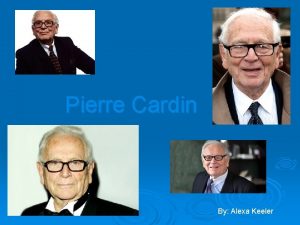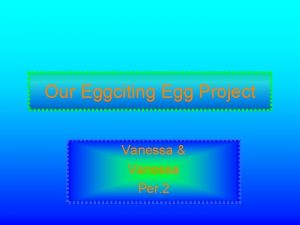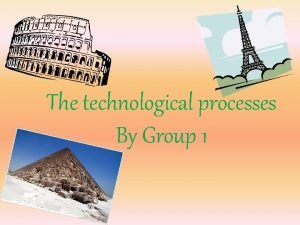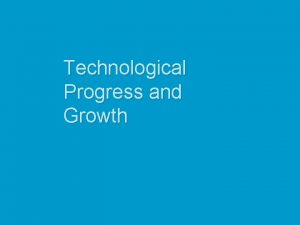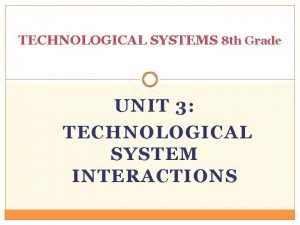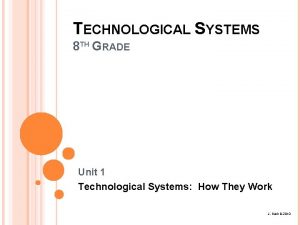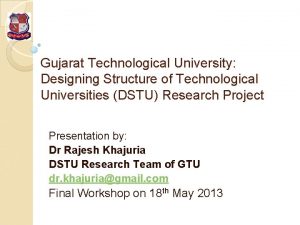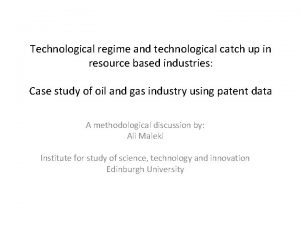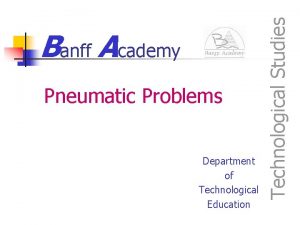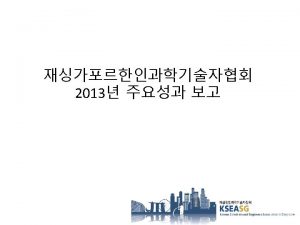WP 2 Technological Harmonization Vanessa Cardin vcardininogs it














































- Slides: 46

WP 2 Technological Harmonization Vanessa Cardin vcardin@inogs. it OGS NERC, HCMR, Uni. HB, PLOCAN, SRL, IFREMER, BLIT, INGV, MI, UNIABDN, CNRS, GEOMAR, IEO, UPC, IMAR General Assembly 2017 Vilanova i la Geltrú, Spain; 27 – 29 June 2017

WP 2 – Technological Harmonization Objectives The main objective of this work package is to review the current status of existing operational systems and to define the best technical practices for compatible, robust and cost effective systems on a variety of fixed platforms.

WP 2 – Technological Harmonization WP Highlights Collection of information Open Ocean Observatories Yellow Pages Website Handbook on relevant info about sensors and devices tested Development of tools aimed at the harmonization of sites ü Technical Guidelines of standards of acceptability for common sensor interoperability protocols ü Open source SMLE software Handbook of Best Practice together with WP 3

WP 2 – Technological Harmonization WP Highlights Collection of information & Dissemination All the information concerning the observatories • Position • Oceanographic characteristics of the site • Contact person • Hardware • Software

WP 2 – Technological Harmonization WP Highlights Dissemination of information Open Ocean Observatories Yellow Pages – O 3 YP Currently the O 3 YP includes: 254 sensors; 208 hardware components; 172 manufactures; Two flyers were created to disseminate O 3 YP

WP 2 – Technological Harmonization WP Highlights Dissemination of information Handbook on relevant info about sensors and devices tested It provides an overview of the experience of application of the most common sensors and on practical directions helpful for the user and it is a powerful tool to network the observatory managing teams Highlights: Mapping/directory of observatory components from 22 fixed open ocean observatory (what, where, who, etc. . ) to push the networking operating staffs at the observatories Comparative analysis of technologies, shallow vs. deep, long term resistance (biofouling)

WP 2 – Technological Harmonization Development of tools Technical Guidelines of standards of acceptability for common sensor interoperability protocols Tools aimed at the harmonization of site: development of OGC Standards in the SWE framework ü Open source SMLE software

WP 2 – Technological Harmonization WP Highlights Handbook of Best Practice together with WP 3

WORKPACKAGE HIGHLIGHTS

WP 2 – Technological harmonization O 3 Yellow. Pages “Open Ocean Observatories Yellow Pages – O 3 YP”A Fixo 3 output for all the community www. esonetyellowpages. com

WP 2 – Technological harmonization O 3 Yellow. Pages Open access catalogue of sensors, hardware and services related with ocean observatories; Freely available on line; All the users can search for specific sensors; Authenticated users can add sensors, services or hardware;

WP 2 – Technological harmonization O 3 Yellow. Pages Observatory Reference for potential users: - only observatory name, not an quality evaluation

WP 2 – Technological harmonization O 3 Yellow. Pages An open access database dedicated to deep-sea and ocean services: 260 sensors 218 hardware components 176 manufactures Deep-sea services : Gliders, ROV, data processing, etc. >450 contacts were performed with the industry.

WP 2 – Technological harmonization O 3 Yellow. Pages O 3 YP as a crucial database for Sensor Registry implementation; Sensor. ML Editor (SMLE), a sensor registration interface, useful interoperability feature;

WP 2 – Technological harmonization O 3 Yellow. Pages Outputs- Flyers to disseminate “Open Ocean Observatories Yellow Pages – O 3 YP” Flyers to be distributed on workshops, symposiums and conferences.

WP 2 – Technological harmonization O 3 Yellow. Pages “Open Ocean Observatories Yellow Pages - O 3 YP” statistics: Number of different visitors: increasing during the last year

WP 2 – Technological harmonization O 3 Yellow. Pages “Open Ocean Observatories Yellow Pages - O 3 YP” statistics:

WP 2 – Technological harmonization HANDBOOK ON RELEVANT INFO ABOUT SENSOR AND DEVICE TESTED Purpose: To gather the relevant information on testing and long -term use of sensors and devices used within the Fix. O 3 project, to produce a sort of comprehensive guide supporting the use of common sensors and the integration of new sensors in different kinds of observatories (seafloor stations, moorings, buoys) Task 2. 3: Assessment of existing and novel hardware. Lead by INGV

WP 2 – Technological harmonization Task 2. 3: Assessment of existing and novel hardware. Lead by INGV Method: a questionnaire was designed to collect all relevant experience about test results of sensors/devices used. Adopted criteria: 1. high representativeness, representativeness to collect the widest possible range of experiences 2. suitable to all kind of sensors and operating system 3. easily understandable, understandable with short and clear questions 4. quick dissemination and completion in by the partner users

WP 2 – Technological harmonization Task 2. 3: Assessment of existing and novel hardware. Lead by INGV Only 16 of the 23 observatories systems operating in Fix. O 3, replied to the questionnaire. WHY? Certainty the questionnaire was an effective tool in gathering information but not enough to encourage partners to spent time in collaborating Need to identify new and more automatic solutions allowing to share knowledge between partners/observatories Observatory name Istitution 1 ANTARES CNRS 2 DELOS MBARI 3 E 2 M 3 A OGS 4 ESTOC PLOCAN 5 FILCHNER RONNE Uni Res. AS 6 FRAM AWI 7 DYFAMED 8 NEMO SN 1 INGV 9 PAP NOC 10 OBSEA UPC 11 PYLOS/E 1 M 3 A HCMR 12 STATION M Uni Bergen 13 W 1 -M 3 A CNR 14 CIS GEOMAR 15 BISCAY AGL IEO 16 LION CNRS-INSU

WP 2 – Technological harmonization Task 2. 3: Assessment of existing and novel hardware. Lead by INGV Questionnaire structure: The questionnaire consists in 5 different sections regarding both technical aspects of sensor performance and some general final comments about the own experience in their use A. Installation sensor/device information B. Mechanical performance: Relevant info on mechanical robustness C. Relevant info on electronic damages D. Relevant info on data quality E. Final free comments of the user

WP 2 – Technological harmonization Task 2. 3: Assessment of existing and novel hardware. Lead by INGV Some number coming from the evaluated systems: Test results allow to evaluate a total of 112 sensors performance distributed over different type of observing system Observing system Number of sensors 6 Bottom stations 42 10 Moorings 44 8 Buoys 26 Total 112

WP 2 – Technological harmonization Task 2. 3: Assessment of existing and novel hardware. Lead by INGV Handbook users: Scientist engineers ranging from the operational level to the research activities Benefits: 1. to evaluate the best sensor performance across the different systems; 2. to know the most common warnings for a sensor with a particular configuration; 3. to disseminate recurring problems of a sensor regardless of the used system; 4. to know and to compare test results on the main sensor peculiarity (e. g. robustness, reliability, endurance) before including it in very long experiments such as in case of permanent cabled observatories.

WP 2 – Technological harmonization Task 2. 3: Assessment of existing and novel hardware. Lead by INGV Comparison between technologies, devices and applications for a critical evaluation of the best sensor uses Handbook contents focuses on specific case studies Comparison between shallow and deep application of p. H and p. CO 2 sensors Experiences with CH 4 sensors: Ui. T and INGV case studies Development of new strategies applied to long term monitoring systems: defence from biofouling Evidences of TNA tests

WP 2 – Technological harmonization Task 2. 3: Assessment of existing and novel hardware. Lead by INGV CONCLUSIONS A large effort has been done to produce this handbook that offers a synoptic view of the main devices in use in Fix. O 3. This tool should be opened to a wider observatory community (e. g. ATLANTOS, EMSO, etc) and should be sustained and maintained alive in order to continuously share the achieved knowledge and best practices between observatory operating staffs.

WP 2 – Technological harmonization Task 2. 3: Assessment of existing and novel hardware. Lead by INGV Thanks to everyone who have spent time participating and contributing to the writing of this handbook …. Never too late to join in!

Task 2. 6 Eric Delory eric. delory@plocan. eu PLOCAN Partners: PLOCAN, MARUM, UPC, SLR, HCMR, 52°NORTH, IFM-GEOMAR, IFREMER, OGS General Assembly 2017 Vilanova i la Geltrú, Spain; 27 – 29 June 2017

Core to T 2. 6: Sensor. ML, a component of the SWE Standards suite Current OGC Standards in the SWE framework are: Observations & Measurements (O&M) –The general models and XML encodings for observations and measurements. PUCK Protocol Standard – Defines a protocol to retrieve a Sensor. ML description, sensor "driver" code, and other information from the device itself, thus enabling automatic sensor installation, configuration and operation. Sensor Model Language (Sensor. ML) – Standard models and XML Schema for describing the processes within sensor and observation processing systems. Sensor Observation Service (SOS) – Open interface for a web service to obtain observations and sensor and platform descriptions from one or more sensors. Sensor Planning Service (SPS) – An open interface for a web service by which a client can 1) determine the feasibility of collecting data from one or more sensors or models and 2) submit collection requests. SWE Common Data Model – Defines low level data models for exchanging sensor related data between nodes of the OGC® Sensor Web Enablement (SWE) framework. SWE Service Model – Defines data types for common use across OGC Sensor Web Enablement (SWE) services. Five of these packages define operation request and response types. Task 2. 6 Lead PLOCAN Partners: MARUM, UPC, SLR, HCMR, 52°NORTH, IFM GEOMAR, IFREMER, OGS

Example of SWE Architecture Sensor System

Objectives and outcomes of T 2. 6: Eased and harmonised standard sensor description Need: A tool for facilitating the creation of sensor and sensor platform descriptions Approach OGC Sensor. ML 2. 0 is an OGC standard for providing metadata about sensors and sensor systems Currently in development: Marine Sensor Web Profile define which elements of Sensor. ML are relevant for marine sensors Idea: Build an editor for Sensor. ML smle Builds on ESONET development (SML 1. 0) and integrates Fix. O 3 Graphical user interface Ensure that the users provide valid inputs

Objectives and outcomes of T 2. 6: Eased and harmonised standard sensor description smle has been completed in a first full version: http: //pilot. 52 north. org: 3000/#/ Linked to ESONET-FIx. O 3 yellow-pages for automated template generation (Task 2. 5) Sync with Fix. O 3 Observatory credentials Developed as a cooperation of Fix. O 3 and Ne. XOS Available as open source software: https: //github. com/52 North/smle






WP No – WP title Remaining Activity Task partners to beta-test the tool Feedback to Github

T 2. 6 Legacy Open OGC SWE Sensor. ML editor Sync ed with Fix. O 3 observatory credentials Sync ed ESONET Fix. O 3 Yellow Pages

Future for infra development Train users create a standard inventory Bind SOS services to Fix. O 3 existing database Demonstrate benefits to operators and users

WP 2 – Technological harmonization Collaborations & Legacy O 3 YP Improve links between the current users and the potential users; > 450 contacts were performed with the industry Fix. O 3 collaboration between WP 2 and WP 4 on the use of the O 3 YP for sensor registry and metadata constitution Sensor Web Enablement approach of Marine Infrastructures. O 3 YP- An useful tool that can be used during following EMSOproject O 3 YP-continuous sensors update, new sensors, new manufactures, etc. O 3 YP & Sensor registry – a work to be applied and developed during EMSO-ERIC, EMSO-DEV. Paper submission

WP 2 – Technological Harmonization Collaboration Cross collaboration between tasks and Workpackages Specially with: WP 3 Procedural Harmonization WP 4 Data Harmonization WP 5 Innovation through industry WP 11 Optimization of ocean observing capability WP 12 Research and development on critical observatory functions

WP 2 – Technological Harmonization Collaboration ü Collaboration between WP 2 and WP 3 for the release of the Best Practices Handbook ü Collaboration between WP 2 and WP 4 on the use of the O 3 YP for sensor registry and metadata constitution is of crucial importance for the Sensor Web Enablement approach of Marine Infrastructures ü Collaboration with WP 9 providing the on line tool for publishing and up to date observatories information

WP 2 – Technological Harmonization Collaboration Cross collaboration with other Projects and Programs NATIONAL PROGRAMS (RITMARE, MOOSE, ecc. ) EU PROJECTS Nexos Atlant. OS …. . ESFRI PROGRAMS EMSO ICOS EMODnet (Physics & Chemistry) Ocean. SITES, Euro. GOOS and Mon. GOOS

WP 2 – Technological Harmonization Lessons Learned Questionnaire methodology relatively effective in gathering information but often not enough engaging to encourage partners in collaborating (only 16 of the 23 observatories systems operating in Fix. O 3, replied to the questionnaire) Need to identify new and more automatic solutions allowing to share knowledge between partners/observatories

WP 2 – Technological Harmonization Remaining Activity All the tasks have been completed successfully! Task 2. 1: Review of the current status of all fixed observing sites Task 2. 2: A User knowledge Base for TNA infrastructures Task 2. 3: Assessment of existing and novel hardware Task 2. 4: Harmonization of Data Quality Assurance across fixed platforms Task 2. 5: Develop the “Open Ocean Observatories Yellow Pages” Task 2. 6: Develop and promote sensor interoperability 10 Deliverables sent on time! 1 asked for a

WP 2 – Technological Harmonization Fix. O 3 Legacy On line tool for publishing and up to date information Technological Knowledge migration to new projects and programs O 3 YP An useful tool that can be used during EMSO ERIC; including sensors update, new sensors, new manufactures, etc. O 3 YP & Sensor registry – a work to be applied and developed during EMSO ERIC Methodology useful to set up the EMSO ERIC Observatory (Digital ? ) Handbook Regional teams networking/exchange/integrations/ joint activities
 Vanessa cardin
Vanessa cardin Where was netball invented
Where was netball invented Data harmonization best practices
Data harmonization best practices Grade harmonization
Grade harmonization Global harmonisation task force
Global harmonisation task force Tesco social factors
Tesco social factors Technological determinism
Technological determinism Technological fix definition
Technological fix definition Pama technological support
Pama technological support What is technological modelling
What is technological modelling Types of business environment
Types of business environment The mongols made no technological breakthroughs
The mongols made no technological breakthroughs 5 technological processes
5 technological processes Political economic
Political economic Which is one limitation to technological design
Which is one limitation to technological design Visvesvaraya technological university nagpur
Visvesvaraya technological university nagpur Technological process definition
Technological process definition Types of technological systems
Types of technological systems Latvian technological center
Latvian technological center Ufa state petroleum technical university
Ufa state petroleum technical university Technological leader
Technological leader Teori technological determinism
Teori technological determinism The mongols made no technological breakthroughs
The mongols made no technological breakthroughs Kitchen design
Kitchen design Institute for prospective technological studies
Institute for prospective technological studies Scientific vs technical
Scientific vs technical Technological dualism
Technological dualism Technology discontinuity
Technology discontinuity Danish technological university
Danish technological university Technological gap and product cycle model
Technological gap and product cycle model Ascoulor
Ascoulor Technological dualism
Technological dualism Technological competitiveness
Technological competitiveness 5 major technological trajectories
5 major technological trajectories Technological university of tajikistan
Technological university of tajikistan Convergence technology definition
Convergence technology definition Five things we need to know about technological change
Five things we need to know about technological change Technology risk examples
Technology risk examples Importance of technological innovation
Importance of technological innovation Technological literacy definition
Technological literacy definition Technological design process definition
Technological design process definition Contoh spiral of silence dalam kehidupan sehari-hari
Contoh spiral of silence dalam kehidupan sehari-hari Vanessa gaffar
Vanessa gaffar La edad de rosa es 3 veces mayor que la edad de jesus
La edad de rosa es 3 veces mayor que la edad de jesus Meja significado
Meja significado Loi de vanessa
Loi de vanessa Vanessa prasad permaul
Vanessa prasad permaul

